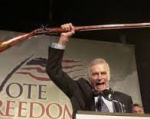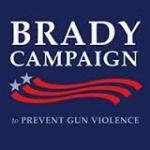As an NRA Life Member, I get emails from all the pro-gun organizations and the last several days my Inbox had plenty of communications about the PBS documentary which aired last night. As you can also probably imagine, the warnings from the pro-gun crowd ran from dire to much worse. I should add that in this case I was also contacted by PBS who asked me to preview the show which I did, and here’s what I saw.
My gun friends who subscribe to the Charlton Heston battle-cry “from my cold, dead hands” had nothing to fear. The documentary is an extremely balanced view of the NRA’s defeat of the federal gun bills in 1999 and again in 2013. Some of the program’s newsreel footage is not for the faint of heart, particularly films from Columbine High School, the shooting of Gabby Giffords and the slaughter at Sandy Hook. There is also some candid commentary from pro-gun advocates like Larry Pratt and an emotion-laden “How could they vote that way?” complaint from Vice President Joe. None of the current NRA leadership would agree to be interviewed but they really had nothing to fear since the film covers the rise and current stance of Wayne LaPierre and his team in a balanced and honest way.
 The program follows the transformation of the NRA from an organization devoted to hunting and sport shooting to one focused primarily on beating back gun control efforts in Washington, D.C. This changed with the emergence of Wayne LaPierre and a coterie of hard-core, conservative board members who then found themselves on the losing end of legislative battles in 1993-94 (Brady bill and assault weapons ban) but would never again wind up on the short end. Gunned Down does not really explain how this shift in direction and message suddenly became (and still remains) so successful, given that the geography (Southern) and demographics (blue-collar White males) of the membership has not substantially changed.
The program follows the transformation of the NRA from an organization devoted to hunting and sport shooting to one focused primarily on beating back gun control efforts in Washington, D.C. This changed with the emergence of Wayne LaPierre and a coterie of hard-core, conservative board members who then found themselves on the losing end of legislative battles in 1993-94 (Brady bill and assault weapons ban) but would never again wind up on the short end. Gunned Down does not really explain how this shift in direction and message suddenly became (and still remains) so successful, given that the geography (Southern) and demographics (blue-collar White males) of the membership has not substantially changed.
One of the key moments in the NRA’s rise to lobbying power, according to Gunned Down, was the NRA’s allegedly decisive role in the 2000 electoral victory of George W. Bush. The narrative is based primarily on post-election statements by Clinton who said that Gore lost because of NRA voters in Ohio, Arkansas and Gore’s home state of Tennessee. But Tennessee, like most of the South, was gradually shifting blue to red well before the 2000 election, with Clinton-Gore receiving a smaller percentage of the total vote in 1996 than in 1992. What probably swung Ohio into the 2000 Bush column was the increased activity of Evangelicals, who would then play a decisive role in Bush’s re-election in 2004. Given the fact that two-thirds of the NRA membership live in Southern and border states, it shouldn’t surprise that NRA-backed candidates are strong south of the Mason-Dixon line. On the other hand, the NRA mounted a big push last year to toss out Connecticut’s incumbent Governor, Dannel Malloy, but the fact that Malloy rammed through a major rewrite of the state’s gun law after Sandy Hook didn’t hurt him one bit.
Given its time-frame, the PBS documentary does not cover a tectonic shift in the gun-control landscape that has occurred over the past 18 months. I am referring to energetic and sustained grass-roots efforts by groups like Everytown and Colorado Ceasefire, the latter playing a formative role in the expansion of Colorado background checks in 2013. Everytown now claims more than 2.5 million supporters, not bad for an organization that started operating the day after Sandy Hook. The NRA makes headlines when the focus is on Washington, D.C., but they have never garnered the kind of media attention that Shannon Watts and her group received when they got Target to ask its customers not to bring guns into their stores.
It won’t be easy for the gun lobby to paint this production as just another example of how the liberal media scorns the value of guns. But the media may soon realize that what was once a good story may now need a different end.

Recent Comments